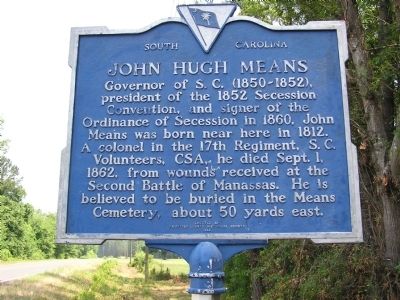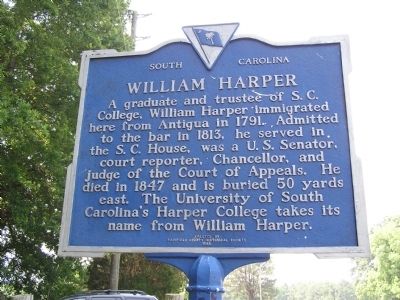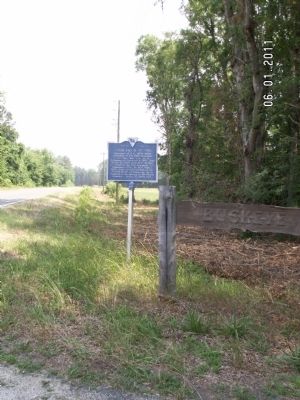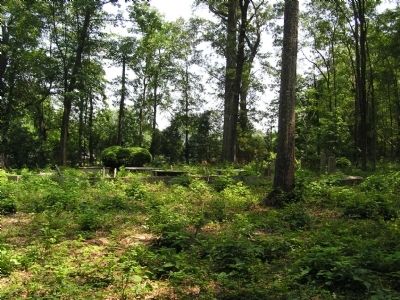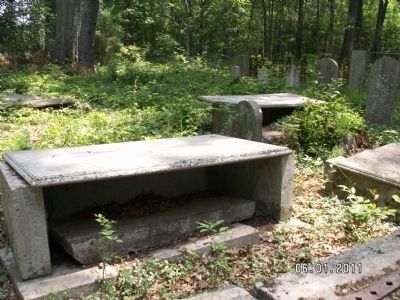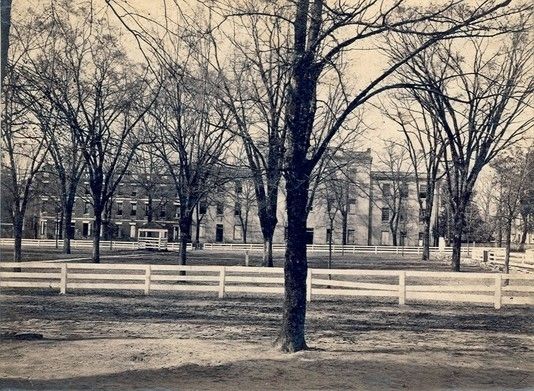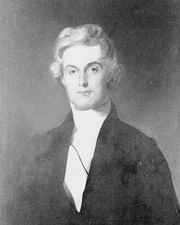Salem Crossroads in Fairfield County, South Carolina — The American South (South Atlantic)
John Hugh Means/William Harper
Governor of S.C. (1850-1852), president of the 1852 Secession Convention, and signer of the Ordinance of Secession in 1860, John Means was born near here in 1812. A colonel in the 17th Regiment, S.C. Volunteers, CSA, he died Sept. 1, 1862, from wounds received at the Second Battle of Manassas. He is believed to be buried in the Means Cemetery, about 50 yards east.
(Reverse):
A graduate and trustee of S.C. College, William Harper immigrated here from Antigua in 1791. Admitted to the bar in 1813, he served in the S.C. House, was a U.S. Senator, court reporter, Chancellor, and judge of the Court of Appeals. He died in 1847 and is buried 50 yards east. The University of South Carolina's Harper College takes its name from William Harper.
Erected 1983 by Fairfield County Historical Society. (Marker Number 20-15.)
Topics. This historical marker is listed in these topic lists: Education • Government & Politics • War, US Civil. A significant historical month for this entry is September 1833.
Location. 34° 28.055′ N, 81° 17.633′ W. Marker is in Salem Crossroads, South Carolina, in Fairfield County. Marker is on Ashford Ferry Road (County Route 18), on the right when traveling north. 3 miles north of Salem Crossroads. Touch for map. Marker is in this post office area: Blair SC 29015, United States of America. Touch for directions.
Other nearby markers. At least 8 other markers are within 11 miles of this marker, measured as the crow flies. Battle of Mobley's Meeting House (approx. 1.4 miles away); Fort Wagner (approx. 1.9 miles away); Feasterville Female and Male Academy (approx. 4½ miles away); R. Aubrey Harley Bridge (approx. 7.9 miles away); Industry Evolution on the Broad River (approx. 9.7 miles away); a different marker also named Industry Evolution on the Broad River (approx. 9.7 miles away); The Oaks (approx. 9.9 miles away); Old Brick Church (approx. 10.4 miles away).
Additional commentary.
1. John Hugh Means
From Wikipedia:
John Hugh Means (August 18, 1812 – August 30, 1862) was the 64th Governor of South Carolina from 1850 to 1852 and an infantry colonel in the Confederate States Army during the American Civil War. He was killed in action at the Second Battle of Manassas, one of a handful of pre-war well-known politicians to perish during the conflict.
Early life and career
Born in the Fairfield District of South Carolina, Means was educated at Mount Zion College in Winnsboro and he graduated from South Carolina College in 1832. He became a planter and his outspoken support of States' rights led him to his election in the General Assembly. During the agitation of secession in the decade prior to the Civil War, Means was elected in 1850 as Governor of South Carolina by the General Assembly, with Lieutenant Governor Joshua John Ward. He presided over a state convention in 1852 that passed a resolution stating that South Carolina had the right to secede if the Federal government sought in any way to disturb the institution of slavery. Furthermore, Means prepared the state for war by increasing the funding of the state militia.
Civil War
Means signed the Ordinance of Secession in 1860 and enrolled in the Confederate Army being elected to Colonel of the 17th South Carolina Infantry. The regiment saw action in Virginia at the battles of Malvern Hill during the Peninsula Campaign and then at the Rappahannock Station in prelude to the Second Battle of Manassas. As a part of Longstreet’s corps, the 17th Regiment arrived at 11 a.m. on August 29 to repulse an attack by Pope on the Confederates' right flank. After stopping the Union forces, the Confederates counterattacked and Means was killed in the fighting.
— Submitted September 25, 2011, by Anna Inbody of Columbia, South Carolina.
2. William Harper
Wikipedia:
Political career
Born in Antigua and partly educated in Baltimore, Harper became one of the most prominent lawyers in Columbia during the 1810s. After a brief stint as a chancellor in the Missouri territory, Harper returned to South Carolina in 1823. In 1826 Governor Richard Manning appointed Harper to fill the U.S. Senate seat that had become vacant with the death of John Gaillard. Harper served from March 28 until December 7 of 1826, when the South Carolina legislature elected William Smith.
Returning to his home state, Harper moved to Charleston and became active in state politics. He served in the state house of representatives, the South Carolina Court of Appeals, and as state chancellor, an office he held from 1835 until his death. Throughout the 1820s and 1830s, Harper was an active defender of South Carolina, free trade, and state rights. He prominently supported the nullification movement led by John C. Calhoun, and argued in a series of court opinions that states in the Union were sovereign political entities, each possessing the right to reject federal laws it found unconstitutional.
Defense of Slavery
Harper is probably best remembered as an early and important representative of pro-slavery thought. His Memoir on Slavery, first given as a lecture in 1838, and reprinted in the Southern Literary Journal, classed Harper as a leading proponent of the notion that slavery was not merely a necessary evil, but a positive social good.
Harper advanced several philosophical, racial, and economic arguments on behalf of slavery, but his central idea was that "slavery anticipates the benefits of civilization, and retards the evils of civilization." The slaveholding South, he contended, had achieved a social balance that allowed for steady economic and technological progress, while avoiding the chaos of urban and per's assessment of other nations around the world confirmed this point of view: non-slaveholding civilizations in northern climates, such as Great Britain, were riven by inequality, political radicalism, and other dangers. Non-slaveholding civilizations in more southerly areas, meanwhile, such as Spain, Italy, and Mexico, were rapidly slipping into "degeneracy and barbarism." Only in the slaveholding Southern United States, Brazil, and Cuba, could be seen making "favorable progress."
Like nearly every other defender of slavery before 1840, Harper nominally conceded that slavery, at an abstract level, did constitute a sort of (necessary) moral evil. Yet his strong, positive emphasis on the social and economic benefits of the institution separate him from the weaker apologists for slavery in earlier decades. Harper's idea of slavery as a social good put him on par with Thomas Roderick Dew, James Henry Hammond, and other significant
figures in the history of pro-slavery thought.
— Submitted September 25, 2011, by Anna Inbody of Columbia, South Carolina.
Credits. This page was last revised on June 16, 2016. It was originally submitted on September 25, 2011, by Anna Inbody of Columbia, South Carolina. This page has been viewed 1,621 times since then and 29 times this year. Photos: 1, 2, 3, 4, 5, 6, 7. submitted on September 25, 2011, by Anna Inbody of Columbia, South Carolina. • Craig Swain was the editor who published this page.
